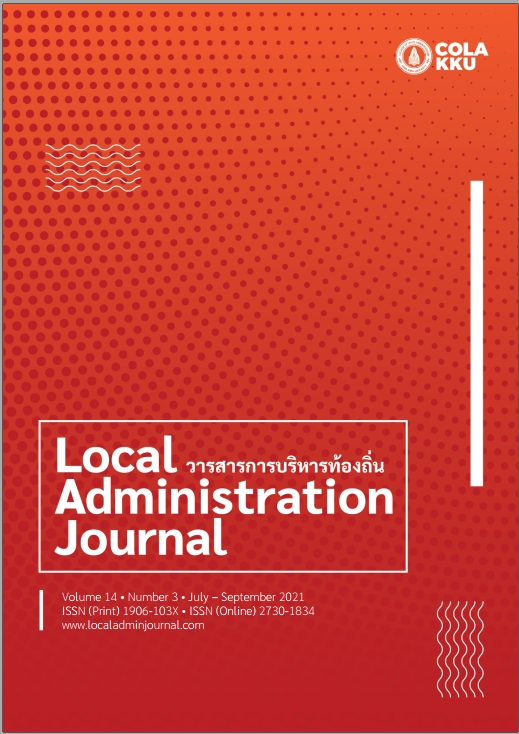Understanding Social Capital Context in Water Resource Management: A Case Study of Nakhon Pa Mak Subdistrict, Bang Krathum District, Phitsanulok Province
DOI:
https://doi.org/10.1234/laj.v14i3.253141คำสำคัญ:
social capital, water resource management, community managementบทคัดย่อ
This research examines the social capital context of water resource management in Nakhon Pa Mak Subdistrict, Bang Krathum District, Phitsanulok Province. It is a qualitative study that includes the examination of relevant documents as well as focus group discussions. It was found that, because of their community's social capital, the Subdistrict was able to collaborate in water resource management. Traditional and cultural activities in the Subdistrict contribute to the dimension of trust. These events brought the members of the Subdistrict together and fostered trust and togetherness. The community leaders and the Subdistrict Administrative Organization played a significant role in connecting people and developing trust among community members via consultation, resulting in mutual understanding and cooperation. In terms of social norms, most community members share the vision and understanding of the seriousness of the water resource crisis, and it has become a norm to make sacrifices in the best interests of the public. They worked together to uphold the community's guideline of sharing water resources. There is a tangible network in the community, such as the water resource management committee, which is an essential instrument in water resource management in the dimension of a coordination network. Furthermore, external networks were established as a support mechanism to stimulate the advancement of water resource management in the Subdistrict. To promote successful and effective water management at a community level, concrete consensus of social capital in the community should be encouraged.
เอกสารอ้างอิง
Adulyahasem, U. & Nakabutra, A. (1998). Strengthening the district from thinking to implementing. Bangkok: Local Community Development Institute.
Besser, T. & Miller, N. (2015). Latino/a immigration, social capital, and business civic engagement in rural prairie towns. In Halstead, J. & Deller, S. (Editor), Social Capital at the Community Level. (p. 174-189). Routledge.
Coleman, J. S. (1988). Social capital in the creation of human capital. American Journal of Sociology, 94, 95-120.
Distanonta, A., Khongmalaia, O., Rassameethesb, R., & Distanontc, S. (2017). Collaborative triangle for effective community water resource management in Thailand. Kasetsart Journal of Social Sciences, 39(3), 374-380.
Hongchayangkun, K., & Thiangchanya, P. (2020). Network creation and management. Retrieved from http://hsmi2.psu.ac.th/upload/forum/paper_1598_5f69ce9304e915f69ce.pdf
Hydro Informatics Institute. (2560). Handbook of community water resource management under The Royal Initiative with Science and Technology. Bangkok: Hydro Informatics Institute. (in Thai)
Intria, M. (2017). Social capital. Narkbhutparitat Journal Nakhon Si Thammarat Rajabhat University, 9(2), 14-25.
Lammerink, M.P., Bolt, E., Jong, D. & Schouten, T. (1999). Community water management: strengthening community water management. PLA Notes 1999, 35. IIED London.
Lin, N. (2000). Inequality in social capital. Contemporary Sociology, 29(6), 785-795.
Office of the National Economic and Social Development Council. (2019). A Study Report on The Impact of Changes in Population Structure and Policy Recommendations toward Develop the Country. Bangkok: Amarin Printing and Publishing Public Company. (in Thai)
Office of the National Water Resources. (2018). Master Plan on Water Resources Management 20 Years (2018-2037). Retrieved from https://wr.pwa.co.th/data/_uploaded/file/Law/ MasterPlan20years2561to2580.pdf (in Thai)
Prime Minister's Delivery Unit. (2021). In 2021, when the dry season is coming soon, the government has issued 9 measures to find water - alleviate suffering. Retrieved from https://www.pmdu.go.th/prepare-for-drought-2564/ (in Thai)
Putnam, R. D. (1993). What makes democracy work? National Civic Review, 82(2), 101-107.
Service Link, Ministry of Higher Education, Science, Research and Innovation. (2015) "Pichet" Visits the Nakhon Pa Mak Community, Phitsanulok, Citing It as A Model Area After Using STI to Manage Water from Repeated Flooding and Drought Problems. Retrieved from
Siamwalla, A., (1999). The evolving roles of the public, local and private sectors. ADB Theme Paper No.5. Manila: Asian Development Bank.
Suvanajata, T. (2001). Social Theory. Bangkok: National Institute of Development Administration.
Talaluck, P., Chinnasri, O., & Thongpunya, T. (2019). Social capital and inheritance of local wisdom Phetchaburi’s art and craft of Look Wa group at Phetchaburi province. Journal of Social Development, 21(2), 28 - 44.
Thai PBS News. (2556). Nakhon Pa Mak Subdistrict: A model community for disaster response. Retrieved from https://news.thaipbs.or.th/content/168919 (in Thai)
Treevanchai, S. (2003). Social capital and the performances of savings groups: A case study in Songkhla. Master thesis, Faculty of Economics, Thammasat University. (in Thai)
Wongsiri, A. (2018). Linking social capital: Public participation and local administrative organization. Humanities & Social Sciences, 35(3), 153-175. (in Thai)
ดาวน์โหลด
เผยแพร่แล้ว
รูปแบบการอ้างอิง
ฉบับ
ประเภทบทความ
สัญญาอนุญาต
ลิขสิทธิ์ (c) 2021 วารสารการบริหารท้องถิ่น

อนุญาตภายใต้เงื่อนไข Creative Commons Attribution-NonCommercial-NoDerivatives 4.0 International License.
บทความทุกเรื่องที่ได้รับการตีพิมพ์ทั้งรูปเล่มและบทความออนไลน์ เป็นลิขสิทธิ์ของวิทยาลัยการปกครองท้องถิ่น มหาวิทยาลัยขอนแก่น



